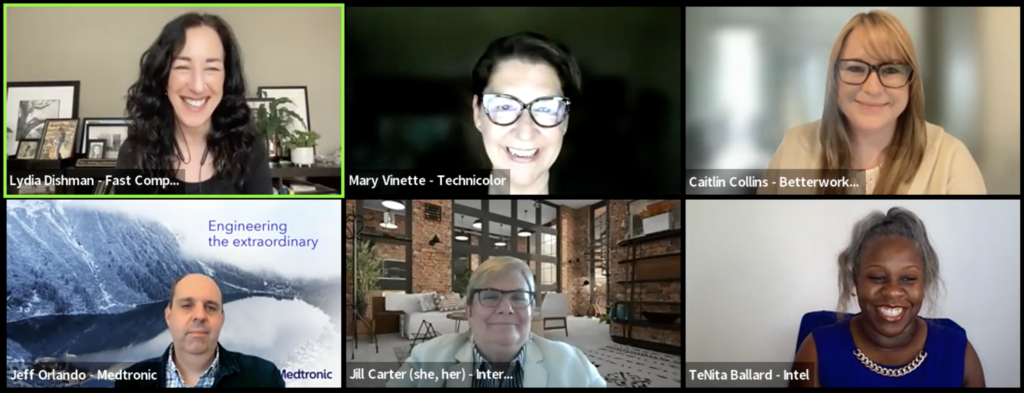Coaching in Fair and Effective Ways in a Hybrid Work Environment


The hybrid work environment is here to stay–and companies need to provide coaching in a personalized way to match an employee’s remote, hybrid, or in-person work schedule. What are the emerging best practices for ensuring equity in such a variety of situations? How can employers avoid favoring those who spend more time in the workplace, known as proximity bias, and offer recognition to those who might feel isolated? How can an environment of inclusion and belonging be fostered? These questions and more were addressed in a panel discussion moderated by Fast Company staff editor Lydia Dishman as part of From Day One’s May virtual conference on new approaches to coaching and recognition.
The session kicked off with a discussion on the difference between coaching and mentoring which, the panel agreed, cross a lot of gray areas. “When I think of mentorship, I think of partnerships, guiding a person with experience that you have been through,” said TeNita Ballard, global diversity and inclusion business partner at Intel. “I look at coaches as eliciting answers already within an employee.”
Ballard gave the example of when she was a mid-level manager and her boss asked her to speak on a panel. She was nervous and felt insecure, but her boss coached her through it so she could succeed. “She wouldn’t have put me on that platform if I wasn’t ready, said Ballard. “What she had to do was coach me to make me laugh or make me realize she asked the right questions: So what are you working on? How are you going to guide them through X, Y, and Z? She coached me through the process.”
Jill Carter, director of leadership and organizational development at Intermountain Healthcare, added that at her organization, mentoring is more for competency development, and coaching is about helping an individual achieve their own goals and objectives.

As a coach, making sure you ask the right questions, questions that a person understands, is critical for success. “Focusing on developing fundamentals, versus always focusing on outcomes, is also key. It makes a huge difference to be able to help guide someone in understanding how to improve certain skills, behaviors, knowledge,” said Caitlin Collins, an organizational psychologist and program-strategy director at Betterworks, a performance-management platform.
Collins learned her first lessons in coaching from her father, who played pro football and then volunteered as a high-school coach. “All that applies in the world of work outside of sports—making sure we’re doing something better on a smaller scale, so that we can improve the outcomes on a bigger scale.”
Mary Vinette, global head of learning and development at Technicolor, spoke to the importance of using coaching to create safe spaces for employees to grow into their best self in the workplace–and gain the confidence that leads to success. She said coaching can lead to higher levels of well-being at home and work, and integrating those two parts of life has become more important than ever in the hybrid workplace.
“If I’m trying to be this person at home, this person at work, this person with my boss, and this person with my direct reports, that’s exhausting,” she said. “What we are in now is a time when everybody’s exhausted. It’s this integration of the whole person that helps you say yes to the things you want, say no to the things you don’t, and be okay with it. It’s the coaches role to create the space to say it’s okay.”
The panelists agreed that implementing an equitable coaching program becomes more difficult with employees working remotely. According to Jeff Orlando, VP of global learning and leadership development at Medtronic, a health care technology company, greater employee initiative may be required to level the playing field. “Raise your hand, let people know if you need to be coached,” he said. “We don’t necessarily know, through our talent processes. We need to hear it from you.”
As far as creating a safe space during virtual meetings, Ballard suggested allowing people to be visible who want to show up on camera, and also allowing people to have their cameras off. “To create a safe place to create well-being,” she said. “We’ll check in versus just jumping into our meeting. How is everyone doing? What's going on?”
Carter added that training coaches to be inclusive is another piece of the puzzle. “We’ve taken the opportunity over the last year to train inclusion coaches, specifically for [diversity, equity and inclusion],” she said. “We actually step our coaches through something called ‘How do you be an inclusive coach?’”
When it comes to implementing a coaching program in the most equitable way possible for all employees, Orlando recommended starting with peer mentoring. “It’s a step in the direction of coaching and broader mentoring,” he said. “There’s been some great research that peer-to-peer mentoring builds affiliation, builds engagement, builds a sense of belonging, and it builds that muscle between employees.”
Jennifer Haupt is a Seattle-based author and journalist.
The From Day One Newsletter is a monthly roundup of articles, features, and editorials on innovative ways for companies to forge stronger relationships with their employees, customers, and communities.